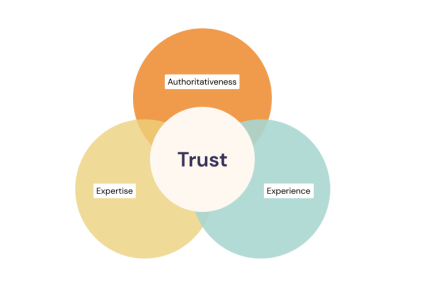3.1.1 What Is E-E-A-T?
E-E-A-T stands for experience-expertise-authoritativeness-trustworthiness. Together, they constitute an important criteria used by Google to rate content on the internet. Until December 2022, the acronym was popularly known as E-A-T. On December 15th, 2022, however, Google updated its criteria to include a content creator’s first-hand experience of the content as an additional parameter on which to rate content quality.
Google now also states that experience, expertise, authoritativeness are all concepts that support the central theme of trust. This is how Google conceptualizes E-E-A-T as contributing to the quality of a web page:
Here’s a look at each of the terms in E-E-A-T:
- Experience: By this, Google wants to ascertain whether the content creator has had any first-hand experience of the topic they are creating content for.
- Expertise: This is an assessment of whether the content creator is an expert on the topic of their Main Content (MC). It is also an assessment of whether users can see the creator’s necessary credentials.
- Authority: This is determined by a few ranking factors, such as how informative the MC is, how long people stay on the page, how many authoritative sites link to the page, how many times it’s shared on social media and whether the page uses an effective SEO strategy.
- Trustworthiness: This refers to whether the creator provides true and factually accurate content that links to (or is linked to) other trustworthy sources. Google determines this through whether it’s clear who is responsible for creating the content. This is typically done by providing as much information about the creator of the page and their objectives as is possible.
Upgrade to a premium plan to access the content.
Most Popular
Upfront
Subscribe
Upfront
(1 payment)
$1000
-
7 chapters
-
53 modules
-
20+ hours of educational videos
-
Monthly 1-on-1 coaching
-
Ready-to-use templates
Fixed Price Guarantee
Recommended
Subscribe
4 Quarterly Payments Of
$250
-
7 chapters
-
53 modules
-
20+ hours of educational videos
-
Monthly 1-on-1 coaching
-
Ready-to-use templates
Fixed Price Guarantee
Best Value
Course Only
Subscribe
Course Only
(1 Payment)
$300
-
7 chapters
-
53 modules
-
20+ hours of educational videos
-
Monthly 1-on-1 coaching
-
Ready-to-use templates
Fixed Price Guarantee




